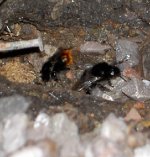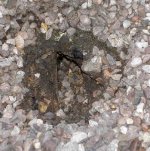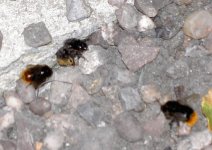Hello Saphire,
They are indeed Bombus lapidarius. Although one of the commoner Bumblebees they do a lot more good than harm. At this time of the year the nest population will be at peak numbers and within a week or two will be producing new queens and males. Shortly after that the colony will decline in numbers and by early September any problems you had with them will be over.
It isn't possible to remove the nest which is usually underground without risking the ire of the colony. Usually bumblebees are very peaceful and easy going insects. I have studied them for over 40 years, and have handled thousands without once being stung once.
Many of our Bumblebee species are in severe decline with only half a dozen species so being relatively common. Yet they are the most important insect group in the country. Without them you would soon have no flowers in your garden or countryside, fruit on your trees and bushes. The only crops that could be grown would be grasses and a few species of nuts that are all wind pollinated. Contrary to popular opinion, Honeybees are not the major pollinators of crops, Bumblebees are.
Putting down any poison will effect far more wildlife than just those bees. I cannot understand what your problem with these bees is, or is it perhaps that you are afraid of them. In all honesty they are generally harmless, unless you upset them severely. If you have children, just warn them to stay away from the nest area, it's as simple as that. As I said in a few weeks your problem will resolve itself naturally. One all the bees have left you can block up the access hole and the problem shouldn't re-occur. All our wildlife needs to be treated with respect, they have just as much right to life as you have, albeit theirs is very short. Only the new Queens will survive until next year.
Harry






